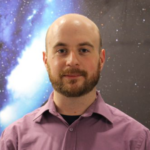Image credit: Carl Knox, OzGrav/Swinburne (“Rainbow Swirl Refracted” is an artistic image inspired by a Black Hole Neutron Star merger event)
A long time ago, in two galaxies about 900 million light-years away, two black holes each gobbled up their neutron star companions, triggering gravitational waves that finally hit Earth in January 2020.
Discovered by an international team of astrophysicists including Northwestern University researchers, two events — detected just 10 days apart — mark the first-ever detection of a black hole merging with a neutron star. The findings will enable researchers to draw the first conclusions about the origins of these rare binary systems and how often they merge.
“Gravitational waves have allowed us to detect collisions of pairs of black holes and pairs of neutron stars, but the mixed collision of a black hole with a neutron star has been the elusive missing piece of the family picture of compact object mergers,” said Chase Kimball, a Northwestern graduate student who co-authored the study. “Completing this picture is crucial to constraining the host of astrophysical models of compact object formation and binary evolution. Inherent to these models are their predictions of the rates that black holes and neutron stars merge amongst themselves. With these detections, we finally have measurements of the merger rates across all three categories of compact binary mergers.”
The research will be published June 29 in the Astrophysical Journal Letters. The team includes researchers from the LIGO Scientific Collaboration (LSC), the Virgo Collaboration and the Kamioka Gravitational Wave Detector (KAGRA) project. An LSC member, Kimball led calculations of the merger rate estimates and how they fit into predictions from the various formation channels of neutron stars and black holes. He also contributed to discussions about the astrophysical implications of the discovery.
Continue to the full Northwestern News story by Amanda Morris.
Learn More
- Paper published in The Astrophysical Journal Letters, “Observation of Gravitational Waves from Two Neutron Star–Black Hole Coalescences“
- Science summary: A NEW SOURCE OF GRAVITATIONAL WAVES: NEUTRON STAR–BLACK HOLE BINARIES
- Christopher Berry’s blog post: GW200115 and GW200105—Completing the set
Media Mentions of CIERA/Northwestern
- NPR, “When A City-Sized Star Becomes A Black Hole’s Lunch, The Universe Roils” by Nell Greenfieldboyce
- Science, “Ripples in spacetime reveal black holes slurping up neutron stars” by Adrian Cho
- The Guardian, “Gravitational waves from star-eating black holes detected on Earth” by Ian Sample
- IFL Science, “Black Holes Swallowing Neutron Stars Whole Seen For The First Time” by Dr. Alfredo Capineti
- Space.com, “Scientists catch 1st glimpse of a black hole swallowing a neutron star” by Meghan Bartels
- Ars Technica, “Physicists confirm two cases of “elusive” black hole/neutron star mergers” by Jennifer Ouellette
- Futurism, “Astronomers May Have Discovered First-Ever “Black Neutron Star” by Victor Tangermann
- The Independent, “SCIENTISTS SEE NEVER-BEFORE-SEEN GRAVITATIONAL WAVE HIT EARTH AFTER COLLISION DEEP IN SPACE” by Andrew Griffin





